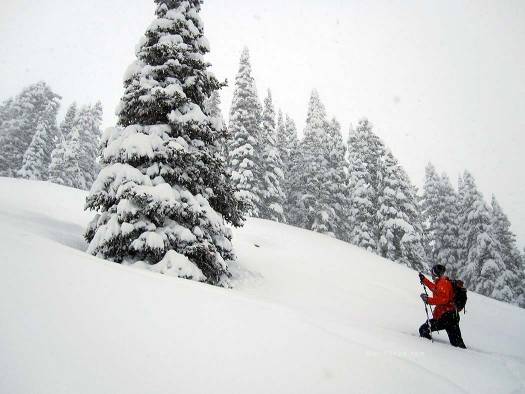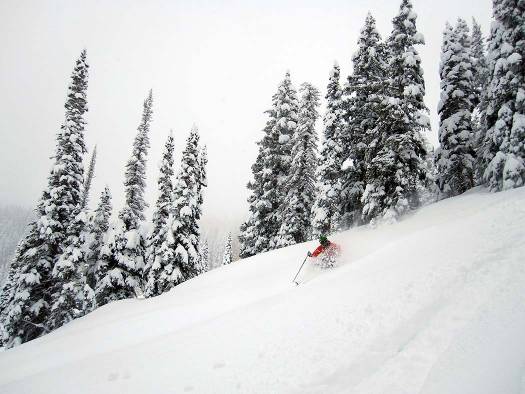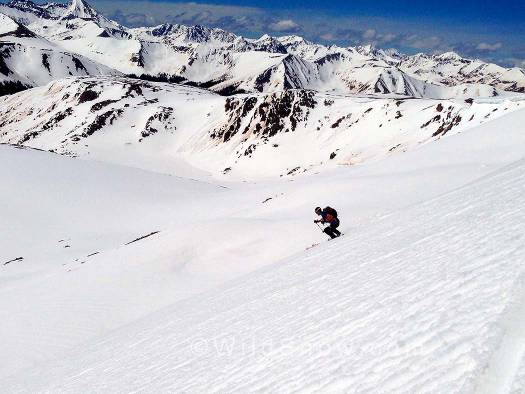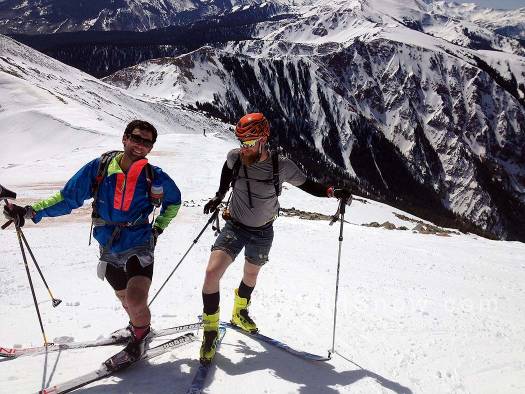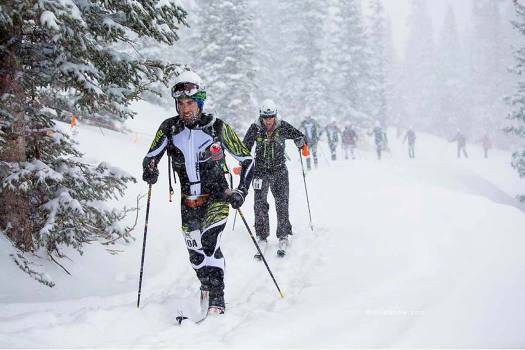
12,000 feet of vert, 25 miles long crossing our local ski areas — Snowmass, Buttermilk, Aspen Highlands, Aspen Mountain — a true human powered ski race.
In whiteout conditions I struggled with my downhill transitions, the wind nearly ripping my skis out my numb hands. Rarely has a “ski mountaineering race” ever really felt like actual mountaineering until this year’s Power of Four at the top of Highlands Bowl, above Aspen. We were one of the last teams waved through for the boot pack. The teams that followed were given the choice of going to the top and still others were eventually denied as the violent wind knocked racers to their knees for minutes at a time.
Hypothermic and exhausted, I felt the sudden relief as my Pierre Gignoux Morpho boots simultaneously snapped into ski mode, clicked into my race bindings and fled the hellish summit. At the time, skiing these incredibly light boots was new to me and skiing them through hip-deep, wind-transported powder seemed inconceivable. As a true testament to their ski ability, I never once thought about the boots as my quads burned through the incredibly agonizing, yet heroically fun descent.
The lightness of the Gignoux Morpho 400 was never in question, nor is the range of motion in touring mode, both of which I still find amazing every time I put the boots on my feet. The stiffness of the carbon gives greater control at high speeds and in variable conditions, more so than any other race boot I have tested.
The durability has also been impressive and at 50+ days on these boots, they have been left muddy, smelly and worn, but still 100% intact. It is impressive to have such a minimalist piece of gear hold up so well when I am that guy whose closest friends cringe if I ask to borrow any piece of equipment.
I have found two criticisms for the boots. Out of all materials that tend to be used for ski boots, carbon (and associated resins) have the highest thermal conductivity. This means that when it is cold outside the boot you don’t have long until that cold saturates the space around your foot. Combine that with the stock ultralight sock liner and an all-night race like the Elk Mountain Grand Traverse and you have a miserable recipe for cold feet.
The tension in the cuff has to be exactly right to ensure firm yet comfortable skiing. Too loose and my shin slops around in the cuff and loses the super power of a carbon exoskeleton. If too tight, circulation begins to get cut off from my already thermally challenged feet on long descents. Unlike most every other closure system on the market the adaptability is completely binary. The choice being open or closed with no micro adjustment short of taking your gloves off and untying and retying tiny little knots. This works great once the tension is dialed, but figure this out before you are doing anything even half-way major.
With the long spring season we had in Colorado this year, warmth was no longer the issue and although I tried to go back to my other superlight, two buckle boots, it was tough to love the extra weight. When peaks with long approaches and steep skiing are calling, it is great to have a minimalist boot that you don’t notice on the way up, with a performance you don’t ever doubt on the way down.
Order a pair of Gignoux boots and bindings here.
(WildSnow guest blogger Doug is co-owner of Cripple Creek Backcountry ski shop near our home base in Colorado. We’re enjoying working with them on partnerships, from a bit of advertising they’re doing in support of our blog mission, as well as a place we go when the WildSnow HQ workshop lacks talent or tools — a rare occasion but it happens. Exciting lead into winter 2014-2015!)
Doug Stenclik is an avid skimo racer and ski mountaineer who lives for sharing the amazing sports of ski touring and splitboarding. Since his first time on skins he was hooked and the obsession has taken him all over the United States and the world pursuing the human powered ski turn. He founded Cripple Creek Backcountry in 2012 and took over the Colorado Ski Mountaineering Race Cup in 2014 to spread knowledge and the love of the sport. In 2019 he took a step back from the ski shop and race promoter life to become a publishing partner with WildSnow.

